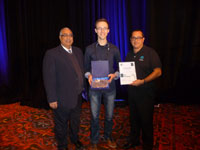Line dancing bacteria win the 2014 Dolomite and Lab on a Chip Video Competition
Posted: 16 December 2014 |
The inaugural MicroTAS Video Competition, run by microfluidics specialist Dolomite and Lab on a Chip, and supported by the Chemical and Biological Microsystems Society, saw first prize awarded to an enterprising – and highly creative – entry submitted by Tijmen Hageman from the Korean Institute of Science and Technology (KIST) Europe GmbH in collaboration with the Unviersity of Twente…


The inaugural MicroTAS Video Competition, run by microfluidics specialist Dolomite and Lab on a Chip, and supported by the Chemical and Biological Microsystems Society, saw first prize awarded to an enterprising – and highly creative – entry submitted by Tijmen Hageman from the Korean Institute of Science and Technology (KIST) Europe GmbH in collaboration with the Unviersity of Twente. This exciting competition gave delegates pre-registered for MicroTAS 2014, held in San Antonio, Texas, the opportunity to win Dolomite microfluidics equipment worth $2,500 by submitting a fun, artistic, surprising, or simply unusual, scientific or educational short film on micro- or nanofluidics, assessed during the event by an international panel of judges.
Tijmen received his award and a $2,500 gift certificate to spend on equipment from microfluidics innovator Dolomite for his short film entitled Magnetotactic bacteria, which brought a humorous approach to the science behind the control of magnetically-active bacteria using an external magnetic field. The winning entry providing a playful demonstration of how, by changing the direction of the field, magnetotactic bacteria can be taught to ‘line dance’ within the channels of a microchip. This has potential applications in areas such as drug delivery, enabling magnetically-active medication to be directed to precisely where it must exert its effect.
To see the winning video, visit https://www.youtube.com/watch?v=3uUL4ooM6KI&feature=youtu.be




